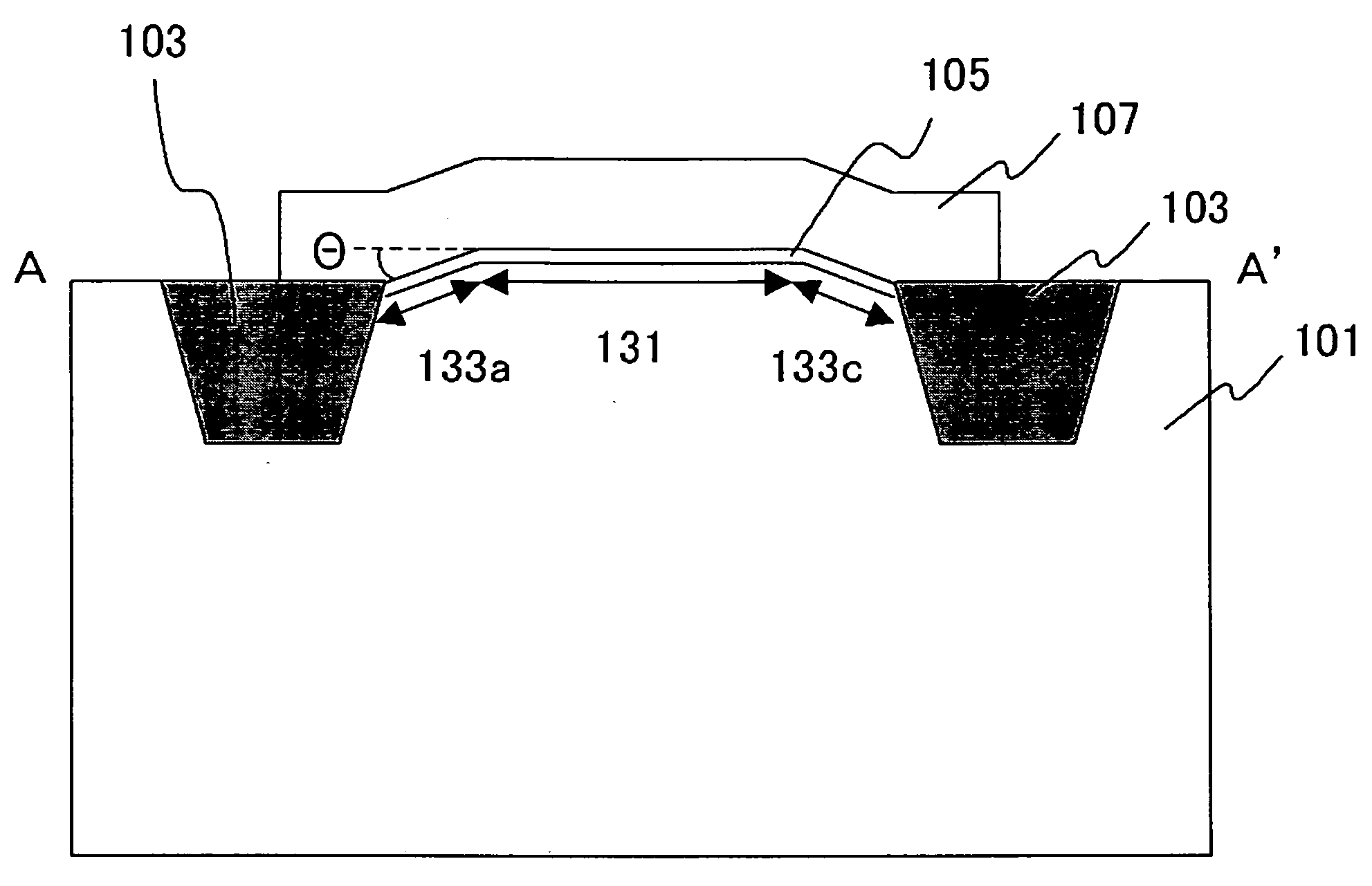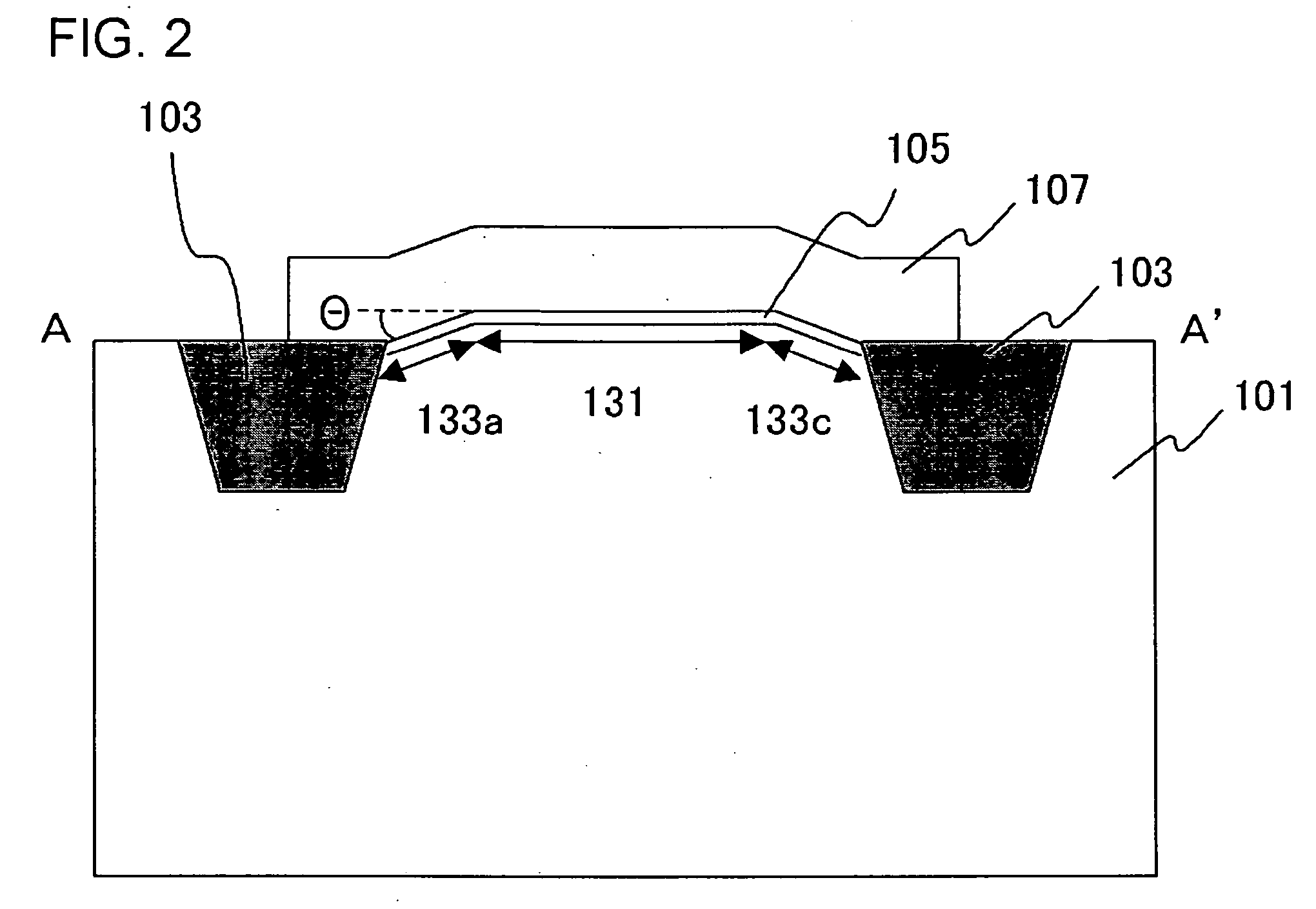Field-effect transistor, complementary field-effect transistor, and method of manufacturing field-effect transistor
a field-effect transistor and field-effect technology, applied in transistors, electrical devices, semiconductor devices, etc., can solve the problems of difficult to improve an on-state current as a channel width is reduced, and achieve the effect of reducing channel mobility, effective channel width, and increasing channel mobility securely
- Summary
- Abstract
- Description
- Claims
- Application Information
AI Technical Summary
Benefits of technology
Problems solved by technology
Method used
Image
Examples
embodiment 1
[0058] This embodiment relates to a P channel type MOSFET. FIG. 1 is a plan view showing a configuration of an MOS type transistor (P channel type MOSFET) according to this embodiment. FIG. 2 is a cross-sectional view taken on line A-A′ of FIG. 1. FIG. 3 is a perspective view schematically showing a configuration near a gate electrode 107 in an MOS field-effect transistor 100.
[0059] The MOS field-effect transistor 100 shown in FIGS. 1 and 2 is formed on a single-crystal silicon substrate 101 having a {100} plane as a principal surface. This invention will be described in connection to an exemplary transistor where the principal surface in the single-crystal silicon substrate 101 is a (100) plane.
[0060] There is formed an element isolation region 103 surrounding the lateral sides of the MOS field-effect transistor 100. The element isolation region 103 is buried in the single-crystal silicon substrate 101. In a plan view, an element forming region surrounded by the element isolation...
embodiment 2
[0090] This embodiment relates to the MOS field-effect transistor 100 described in Embodiment 1 where the inclined surface 133 is curved.
[0091]FIG. 7 is a cross-sectional view schematically showing a configuration of a semiconductor device according to this embodiment, from the same direction as FIG. 2. In FIG. 7, both inclined surfaces 133a and 133c are curved.
[0092] Since in this configuration, the channel region 108 also has the inclined surface 133 as described in Embodiment 1, a relative area of the inclined surface 133 can be increased to an area of a region separating the source / drain regions 129 in the single-crystal silicon substrate 101 seen from the normal line of the principal surface. The inclined surfaces 133a to 133d are configured such that in the crystal axis direction of the single-crystal silicon or an axis direction equivalent to the crystal axis direction, the surface orientation of the inclined surface 133 varies from the crystal axis direction of the sing...
embodiment 3
[0095] This embodiment relates to the MOS field-effect transistor 100 as described in Embodiment 1, where all of the inclined surfaces 133a to 133d are constituted by a plurality of planes.
[0096]FIG. 8 is a cross-sectional view schematically showing a configuration of a semiconductor device according to this embodiment, from the same direction as FIG. 2. In FIG. 8, there is shown a configuration where all of the inclined surfaces 133a to 133c are constituted by three planes having a different surface orientation.
[0097] By this configuration, a plane having a given inclination angle θ can be formed in the inclined surface 133 as is in Embodiment 1, resulting in increase of a ratio of a region for forming the inclined surface 133 to a width of a region for forming the channel region 108 and improvement of channel mobility. Furthermore, since all of the inclined surfaces 133a to 133d are constituted by the plurality of planes, electric field concentration in the end of the element is...
PUM
 Login to View More
Login to View More Abstract
Description
Claims
Application Information
 Login to View More
Login to View More - R&D
- Intellectual Property
- Life Sciences
- Materials
- Tech Scout
- Unparalleled Data Quality
- Higher Quality Content
- 60% Fewer Hallucinations
Browse by: Latest US Patents, China's latest patents, Technical Efficacy Thesaurus, Application Domain, Technology Topic, Popular Technical Reports.
© 2025 PatSnap. All rights reserved.Legal|Privacy policy|Modern Slavery Act Transparency Statement|Sitemap|About US| Contact US: help@patsnap.com



